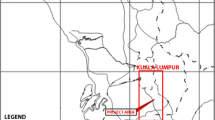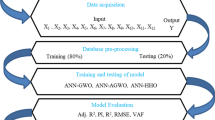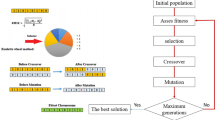Abstract
Pull-out capacity of ground anchors is analogous to axial capacity of piles as both of them apply same methods. These available methods are mostly empirical; therefore, in this paper efficient prediction models for determining the uplift capacity of small ground anchors have been presented using recently developed artificial intelligence (AI) techniques. Multi-objective feature selection (MOFS) has been utilised to find the subset of influential parameters responsible for the pull-out capacity of ground anchors along with the development of prediction equations. MOFS has been applied with artificial neural network and non-dominated sorting genetic algorithm. Prediction models are also presented using two other AI techniques: functional network and multi-variate adaptive regression spline. AI models were compared in terms of different statistical parameters such as mean absolute error, root-mean-square error, correlation coefficient and ranking criterion approach have been implemented to assess the performance of different prediction models.
Similar content being viewed by others
References
Bustamante, M.; Gianeselli, L.: Pile bearing capacity prediction by means of static penetrometer CPT. In: Proceedings of the 2nd European Symposium on Penetration Testing, Amsterdam, pp. 493–500 (1982)
Das, B.M.: Principles of Foundation Engineering, 3rd edn. PWS Publishing Company, Boston (1995)
Bowles, J.E.: Foundation Analysis and Design. Mc-Graw-Hill, New York (1997)
Soleimanbeigi, A.; Hataf, N.: Prediction of settlement of shallow foundations on reinforced soils using neural networks. Geosynth. Int. 13(4), 161–170 (2006)
Ching, J.; Liao, H.J.; Lee, J.Y.: Predicting rainfall-induced landslide potential along a mountain road in Taiwan. Géotechnique 61(2), 153–166 (2011)
Rakhshandehroo, G.R.; Vaghefi, M.; Aghbolaghi, M.A.: Forecasting groundwater level in Shiraz plain using artificial neural networks. Arab. J. Sci. Eng. 37, 1871–1883 (2012)
Sarıdemir, M.; Severcan, M.H.: The use of genetic programming and regression analysis for modeling the modulus of elasticity of NSC and HSC. Arab. J. Sci. Eng. 41(10), 3959–3967 (2016)
Sedighi, F.; Vafakhah, M.; Javadi, M.R.: Rainfall–runoff modeling using support vector machine in snow-affected watershed. Arab. J. Sci. Eng. 41(10), 4065–4076 (2016)
Khairi, M.T.M.; Ibrahim, S.; Yunus, M.A.M.; Faramarzi, M.; Yusuf, Z.: Artificial neural network approach for predicting the water turbidity level using optical tomography. Arab. J. Sci. Eng. 41(9), 3369–3379 (2016)
Lau, D.S.; Simmons, J.V.: Interpretation of field tests on small-scale ground anchors. In: Speciality Geomechanics Symposium: Interpretation of Field Testing for Design Parameters, vol. 1 and 2. National conference publication (Institution of Engineers, Australia), Barton, Australia, pp. 85–88 (1986)
Shahin, M.A.; Jaksa, M.B.: Modelling the pull-out capacity of marquee ground anchors. School of Civil and Environmental Engineering, The University of Adelaide, Adelaide, Research Report No. R174 (2003)
Shahin, M.A.; Jaksa, M.B.: Neural network prediction of pull-out capacity of marquee ground anchors. Comput. Geotech. 32, 153–163 (2005)
Shahin, M.A.; Jaksa, B.: Pull-out capacity of small ground anchors by direct cone penetration test methods and neural networks. Can. Geotech. J. 43, 626–637 (2006)
Samui, P.; Kim, D.; Aiyer, G.: Pull-out capacity of small ground anchor: a least square support vector machine approach. J. Zhejiang Univ. Sci. A (Appl. Phys. Eng) 16(4), 295–301 (2015)
Shahin, M.A.: Use of evolutionary computing for modelling some complex problems in geotechnical engineering. Geomech. Geoeng. 10(2), 109–125 (2015)
Das, S.K.: Artificial neural networks in geotechnical engineering: modeling and application issues. In: Yang, X., Gandomi, A.H., Talatahari, S., Alavi, A.H. (eds.) Metaheuristics in Water, Geotechnical and Transport Engineering, pp. 231–270. Elsevier, London (2013)
Shalan, S.A.B.; Ykhlef, M.: Solving multi-objective portfolio optimization problem for Saudi Arabia stock market using hybrid clonal selection and particle swarm optimization. Arab. J. Sci. Eng. 40, 2407–2421 (2015)
Zhang, K.; Yuan, F.; Guo, J.; Wang, G.: A novel neural network approach to transformer fault diagnosis based on momentum-embedded BP neural network optimized by genetic algorithm and fuzzy c-means. Arab. J. Sci. Eng. (2015). doi:10.1007/s13369-015-2001-6
Guyon, I.; Elisseeff, A.: An introduction to variable and feature selection. J. Mach. Learn. Res. 3, 1157–1182 (2003)
Yang, Y.; Pedersen, J.O.: A comparative study on feature selection in text categorization. In: Proceedings of Fourteenth International Conference on Machine Learning (ICML’97), vol. 97, Nashville, Tennessee, USA, pp. 412–420 (1997)
Forman, G.: An extensive empirical study of feature selection metrics for text classification. J. Mach. Learn. Res. 3, 1289–1305 (2003)
Bolasso, F.R.B.: Model consistent Lasso estimation through the bootstrap. In: McCallum, A., Roweis, S.T. (ed.) Proceedings of 25th International conference on Machine learning, (ICML2008), Helsinki, Finland, pp. 33–40 (2008)
Zare, H.; Haffari, G.; Gupta, A.; Brinkman, R.R.: Scoring relevancy of features based on combinatorial analysis of Lasso with application to lymphoma diagnosis. BMC Genom. 14, S14 (2013)
Maruf, S.; Javed, K.; Babri, H.A.: Improving text classification performance with random forests-based feature selection. Arab. J. Sci. Eng. 41, 951–964 (2016)
He, X.; Zhang, Q.; Sun, N.; Dong, Y.: Feature selection with discrete binary differential evolution. In: Proceedings of International Conference on Artificial Intelligence and Computational Intelligence, AICI 2009, vol. 4, art. no. 5376334, Shanghai, pp. 327–330 (2009)
Zhu, Z.X.; Ong, Y.S.; Dash, M.: Wrapper-filter feature selection algorithm using a memetic framework. IEEE Trans. Syst. Man Cybern. Part B: Cybern. 37(1), 70–76 (2007)
Neshatian, K.; Zhang, M.: Pareto front feature selection: using genetic programming to explore feature space. In: The 11th Annual Conference on Genetic and Evolutionary Computation (GECCO 2009), pp. 1027–1034 (2009)
Cervante, L.; Xue, B.; Zhang, M.; Shang, L.: Binary particle swarm optimisation for feature selection: a filter based approach. In: Proceedings of Evolutionary Computation (CEC), 2012 IEEE Congress, art. no. 6256452, Brisbane, QLD, pp. 881–888 (2012)
Xue, B.; Cervante, L.; Shang, L.; Browne, W.N.; Zhang, M.: A multi-objective particle swarm optimisation for filter based feature selection in classification problems. Connect. Sci. 24(2–3), 91–116 (2012)
Xue, B.; Cervante, L.; Shang, L.; Browne, W.N.; Zhang, M.: Binary PSO and rough set theory for feature selection: a multi-objective filter based approach. Int. J. Comput. Intell. Appl. 13(02), 1450009 (2014)
Deb, K.; Pratap, A.; Agarwal, S.; Meyarivan, T.: A fast and elitist multiobjective genetic algorithm: NSGA-II. IEEE Trans. Evol. Comput. 6(2), 182–197 (2002)
Castillo, E.; Cobo, A.; Gutierrez, J.M.; Pruneda, E.: An introduction to functional networks with applications. Kluwer, Boston (1998)
Castillo, E.; Cobo, A.; Manuel, J.; Gutierrez, J.M.; Pruneda, E.: Functional networks: a new network-based methodology. Comput. Aided Civ. Infrastruct. Eng. 15, 90–106 (2000)
Das, S.K.; Suman, S.: Prediction of lateral load capacity of pile in clay using multivariate adaptive regression spline and functional network. Arab. J. Sci. Eng. 40(6), 1565–1578 (2015)
Friedman, J.: Multivariate adaptive regression splines. Ann. Stat. 19, 1–141 (1991)
Smith, G.N.: Probability and Statistics in Civil Engineering: An Introduction. Collins, London (1986)
Abu-Farsakh, M.Y.; Titi, H.H.: Assessment of direct cone penetration test methods for predicting the ultimate capacity of friction driven piles. J. Geotech. Geoenv. Eng. 130(9), 935–944 (2004)
Author information
Authors and Affiliations
Corresponding author
Rights and permissions
About this article
Cite this article
Mohanty, R., Suman, S. & Das, S.K. Modelling the Pull-out Capacity of Ground Anchors Using Multi-objective Feature Selection. Arab J Sci Eng 42, 1231–1241 (2017). https://doi.org/10.1007/s13369-016-2361-6
Received:
Accepted:
Published:
Issue Date:
DOI: https://doi.org/10.1007/s13369-016-2361-6




